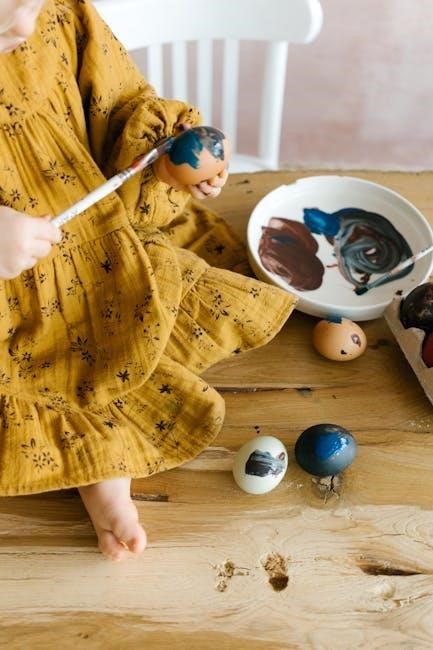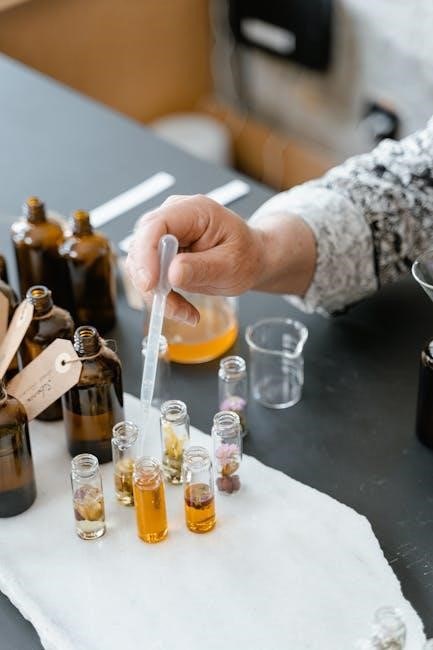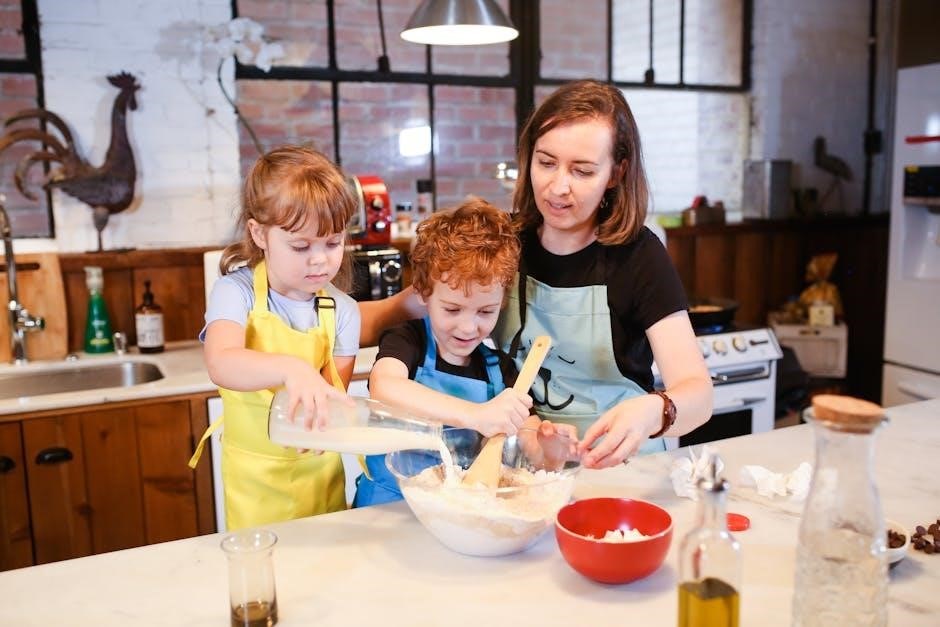Kendamil Mixing Instructions: A Comprehensive Guide
Welcome to your comprehensive guide on preparing Kendamil formula! This guide provides detailed instructions for safely and effectively mixing Kendamil formula‚ ensuring your baby receives optimal nutrition. Follow these steps carefully for a smooth feeding experience.
Kendamil is a popular choice for infant nutrition‚ known for its quality ingredients and manufacturing standards. Originating from the UK‚ Kendamil distinguishes itself by using whole milk as a primary ingredient‚ offering a creamy taste and texture that many babies enjoy. It’s designed to provide essential nutrients necessary for healthy growth and development from infancy onwards.
This formula undergoes rigorous testing to meet international safety standards. It is suitable from birth‚ with follow-on formulas available for older babies. Kendamil also caters to different dietary needs‚ including options for sensitive tummies.
Preparing Kendamil correctly is crucial to ensure your baby benefits fully from its nutritional value and to minimize any digestive discomfort. This guide provides a detailed walkthrough of each step‚ from sterilization to storage‚ to help you confidently prepare each bottle. Understanding the proper mixing techniques not only guarantees safety but also supports your baby’s healthy development during these crucial early months. With the right knowledge‚ feeding time can be a stress-free and bonding experience for both you and your little one.
Essential Equipment for Preparation
To ensure a safe and hygienic preparation of Kendamil formula‚ gathering the right equipment is essential. Start with high-quality baby bottles‚ preferably BPA-free‚ in various sizes to accommodate your baby’s growing appetite. You’ll also need bottle teats appropriate for your baby’s age and feeding pace.

A reliable sterilizer is a must-have‚ whether it’s an electric steam sterilizer‚ microwave sterilizer‚ or sterilizing tablets for cold water sterilization. A kettle for boiling fresh water is crucial‚ and it’s beneficial to have one with temperature control to ensure the water cools to the recommended temperature.
Accurate measuring tools are also important. Use the Kendamil scoop provided with the formula to ensure the correct powder-to-water ratio. A separate‚ clean container for measuring water can also be helpful.
Additionally‚ keep a clean bottle brush for thorough cleaning and a drying rack specifically for baby bottles. Having these items readily available and well-maintained will streamline the formula preparation process‚ making it quicker and safer for your baby. Remember to regularly check and replace any worn or damaged equipment to maintain optimal hygiene.
Step-by-Step Mixing Instructions
Preparing Kendamil formula requires careful adherence to instructions to ensure your baby’s safety and optimal nutrition. First‚ thoroughly wash your hands with soap and warm water. Sterilize all feeding equipment‚ including bottles‚ teats‚ and any measuring tools‚ following the manufacturer’s guidelines.
Next‚ boil fresh‚ potable water and allow it to cool for no more than 30 minutes. This ensures the water is warm enough to dissolve the powder effectively but not too hot‚ which can destroy nutrients. Pour the correct amount of cooled‚ boiled water into the sterilized bottle‚ consulting the Kendamil feeding guide for age-appropriate measurements.
Using the provided Kendamil scoop‚ add the precise amount of formula powder to the bottle‚ leveling off each scoop with a clean‚ flat edge. Avoid overpacking or underfilling the scoop. Secure the teat and cap onto the bottle and shake well until the powder is completely dissolved‚ ensuring no clumps remain.
Before feeding‚ check the temperature of the formula by placing a few drops on your wrist; it should feel lukewarm‚ not hot. Feed your baby immediately after preparation‚ and discard any leftover formula after one hour from the start of feeding. Never save partially consumed bottles for later use.
Water Temperature and Cooling
The temperature of the water used to prepare Kendamil formula is a crucial factor in ensuring both safety and optimal nutrient preservation. It is essential to use freshly boiled water‚ as this sterilizes the water‚ eliminating any potential bacteria that could be harmful to your baby. However‚ using boiling water directly can damage the proteins and nutrients in the formula.
Therefore‚ after boiling‚ the water must be allowed to cool for no more than 30 minutes. This cooling period brings the water temperature down to around 70°C (158°F)‚ which is hot enough to retain its sterilizing properties while minimizing the risk of nutrient degradation. Using a thermometer can help ensure accuracy‚ but if one isn’t available‚ adhering to the 30-minute cooling time is generally sufficient.
Cooling the water properly also prevents scalding when feeding your baby. Always test the temperature of the prepared formula on your wrist before feeding; it should feel lukewarm‚ not hot. Avoid using artificially cooled water‚ such as that cooled in the refrigerator‚ as it may not be adequately sterilized.
Remember‚ the goal is to balance sterilization with nutrient preservation‚ providing your baby with a safe and nutritious feeding experience. Follow these guidelines carefully to ensure the best possible outcome for your little one.
Proper Sterilization Techniques
Ensuring that all feeding equipment is properly sterilized is paramount to protecting your baby from harmful bacteria and infections. Sterilization eliminates microorganisms that can cause illness‚ especially in newborns with underdeveloped immune systems. There are several effective methods for sterilizing bottles‚ nipples‚ and other feeding accessories.
One common method is boiling. Submerge all items in boiling water for at least 10 minutes. Ensure that all parts are completely covered to achieve thorough sterilization. Another popular option is steam sterilization‚ which can be done using an electric steam sterilizer or a microwave steam sterilizing bag. Follow the manufacturer’s instructions carefully‚ as sterilization times may vary.
Cold water sterilization is another alternative‚ involving the use of a special sterilizing solution. Submerge the equipment in the solution for a minimum of 30 minutes‚ changing the solution every 24 hours to maintain its effectiveness. Before handling sterilized items‚ always wash your hands thoroughly with soap and water to prevent recontamination.
Regardless of the method you choose‚ it is crucial to sterilize all feeding equipment before each use‚ especially during the first few months of your baby’s life. Regular and proper sterilization provides a safe and healthy feeding environment for your little one‚ contributing to their overall well-being.
Accurate Powder-to-Water Ratio
Maintaining an accurate powder-to-water ratio is crucial for your baby’s health and well-being when preparing Kendamil formula. Too much powder can lead to dehydration and digestive issues‚ while too little powder may not provide adequate nutrition. Always follow the manufacturer’s instructions precisely to ensure the correct concentration.

Generally‚ Kendamil formula requires one level scoop of powder for every ounce (approximately 30ml) of water. Use the scoop provided with the formula and level it off with a clean‚ dry knife or the built-in leveler on the formula container. Avoid packing the powder into the scoop‚ as this can result in an inaccurate measurement.
Always measure the water first and then add the powder. This ensures the correct final volume of the prepared formula. Using a marked bottle can help you accurately measure the water. Once you’ve added the powder‚ securely fasten the bottle’s nipple and cap‚ and shake well until the powder is completely dissolved. Check for any clumps or undissolved powder at the bottom of the bottle before feeding.
Never alter the recommended powder-to-water ratio. If you have any concerns or questions about the correct preparation‚ consult with your pediatrician or a healthcare professional. Accurate preparation ensures your baby receives the optimal balance of nutrients for healthy growth and development.
Safe Storage Guidelines
Proper storage of Kendamil formula is essential to maintain its quality and safety for your baby. Unopened containers of Kendamil formula should be stored in a cool‚ dry place away from direct sunlight and heat sources. Avoid storing formula in areas with high humidity‚ such as the bathroom or near the stove‚ as this can cause the powder to clump or spoil.
Once the container is opened‚ it should be resealed tightly and used within the timeframe specified on the packaging‚ typically one month. Write the date of opening on the container to help you keep track. Always use a clean‚ dry scoop to measure the powder and avoid contaminating the remaining formula.
Prepared formula should be used immediately‚ but if this is not possible‚ it can be stored in the refrigerator for up to 24 hours. However‚ it’s best to prepare formula fresh whenever possible. Never leave prepared formula at room temperature for more than two hours‚ as this can encourage bacterial growth.
If you are traveling‚ consider using ready-to-feed formula or pre-measured formula dispensers to ensure safe and convenient feeding on the go. Always discard any leftover formula after feeding your baby‚ as bacteria from their saliva can contaminate the remaining milk. Following these storage guidelines will help protect your baby from potential health risks.
Feeding Time Best Practices
Creating a calm and comfortable environment during feeding time is crucial for both you and your baby. Choose a quiet space where you can focus on your baby without distractions. Ensure you are seated comfortably and have all the necessary supplies within reach‚ including the prepared Kendamil formula‚ a clean burp cloth‚ and a bib.
Hold your baby in a semi-upright position to prevent air ingestion and reduce the risk of reflux. Gently offer the bottle‚ ensuring the nipple is filled with formula to avoid your baby swallowing air. Pace the feeding according to your baby’s cues‚ allowing them to pause and take breaks as needed.
Burp your baby frequently during and after the feeding to release any trapped air. Hold your baby upright and gently pat or rub their back until they burp. After feeding‚ keep your baby upright for about 20-30 minutes to aid digestion.
Always monitor your baby for signs of fullness‚ such as turning their head away‚ closing their mouth‚ or slowing down their sucking. Never force your baby to finish the entire bottle. Remember that every baby is different‚ and their feeding needs may vary. Consult with your pediatrician or a lactation consultant for personalized advice on feeding your baby. Creating a positive feeding experience will promote bonding and healthy development;
Discarding Leftover Formula
Properly discarding leftover Kendamil formula is crucial for your baby’s health and safety. Prepared infant formula can harbor bacteria‚ which can multiply rapidly at room temperature‚ potentially causing illness if ingested. To minimize the risk of bacterial contamination‚ it is essential to follow strict guidelines regarding leftover formula.
According to guidelines‚ prepared formula should be used within two hours of preparation if left at room temperature; Once feeding has begun‚ any remaining formula in the bottle should be discarded within one hour. This is because bacteria from your baby’s mouth can contaminate the formula‚ accelerating bacterial growth.
Do not save leftover formula for a later feeding‚ even if it appears untouched. The risk of bacterial contamination outweighs any potential cost savings. Always prepare a fresh bottle of formula for each feeding.
When discarding leftover formula‚ pour it down the drain and thoroughly rinse the bottle and nipple with warm‚ soapy water. Sterilize the bottle and nipple before the next use to ensure optimal hygiene. By adhering to these guidelines‚ you can protect your baby from harmful bacteria and promote their well-being. Remember‚ when in doubt‚ throw it out!
Important Safety Notices and Guidelines
Prioritizing your baby’s safety is paramount when preparing Kendamil formula. Always adhere to these important safety notices and guidelines to minimize risks and ensure your baby receives the best possible nourishment. Breastfeeding is generally considered the best option for infants; consult with your healthcare provider for guidance on infant feeding. Kendamil follow-on milk is intended for babies over six months and should be part of a mixed diet.

Wash your hands thoroughly with soap and warm water before preparing the formula. Sterilize all feeding equipment‚ including bottles‚ nipples‚ and caps‚ according to the manufacturer’s instructions. Always use fresh‚ boiled water that has been cooled to the recommended temperature. Never use repeatedly boiled water.
Carefully measure the correct amount of water and formula powder‚ following the instructions on the Kendamil packaging. An incorrect powder-to-water ratio can lead to nutritional imbalances or digestive issues. Never add extra powder to “enrich” the formula. Always use the scoop provided with the formula and level it off with a clean‚ dry knife or leveling device.

Prepare each bottle fresh‚ right before feeding‚ and discard any leftover formula after one hour from when feeding begins. Never microwave formula‚ as it can create hot spots that could burn your baby. Always check the temperature of the formula before feeding by testing a few drops on your wrist; it should feel lukewarm.
